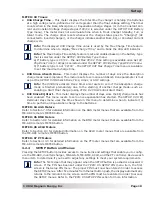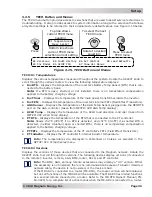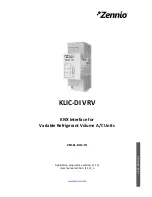
©
2014 Magnum Energy, Inc.
Page 21
Setup
Where should I set Search Watts?
The
Search Watts
setting should be adjusted to the same
power level (or the next lower setting) of the smallest load that you plan to run. If you don’t know
the wattage of the smallest load, turn the switch for the load on and decrease the
Search Watts
setting until the load comes on and stays on.
Info:
Even though the Search Watts feature is on, some connected equipment—even
if they are off—may draw enough current to keep the inverter in Inverter mode (i.e.,
not “Searching”).
• 02B LBCO Setting
–
The
LBCO
menu (Low Battery Cut Out) sets the DC voltage level that
turns off the inverter. This protects the batteries from over-discharge damage. If the battery
voltage drops below the LBCO set-point continuously for more than one minute, the FAULT
LED will come on, the inverter will turn off, and the display will show a “
Low Battery”
status. If
the battery voltage falls below 8.5 volts (12-volt models), 17.0 volts (24-volt models), or 34.0
volts (48-volt models) the FAULT LED and low battery status indications will be immediate.
Default settings:
10.0 VDC
(12v),
20.0 VDC
(24v) or
40.0 VDC
(48v)
Ranges:
9.0-12.2 VDC
(12v),
18.0-24.4 VDC
(24v),
36.0-48.8 VDC
(48v)
Info:
The inverter automatically begins inverting when the DC voltage increases to
≥
12.5 VDC (12-volt models),
≥
25.0 VDC (24-volt models), or
≥
50.0 VDC (48-volt
models). If AC power is available and connected to the inverter’s input, the inverter
automatically clears the low battery fault, passes the input AC power to the output, and
begins charging the batteries.
Where should I set the LBCO setting?
If your goal is to not discharge your batteries more
than 20%*, then set the
LBCO
setting from 11.5 - 12.2 VDC (12-volt models), 23.0 - 24.4 VDC
(24-volt models), or 46.0 - 48.8 VDC (48-volt models). In some applications, such as those in-
stalled in an off-grid home or when doing a lot of RV dry-camping, you may want to cycle down
to 50%* by setting the LBCO from 10.0 to 11.4 VDC (12-volt models), 20.0 - 22.8 VDC (24-volt
models) or 40.0 to 45.6 VDC (48-volt models). In extreme circumstances, you have the ability to
discharge the batteries to 80%* by setting the LBCO to 9.0 or 9.5 VDC (12-volt models), 18.0 -
19.0 VDC (24-volt models), or 36.0 or 38.0 VDC (48-volt models) before recharging.
* These are rough estimates. For accurate battery monitoring, use the ME-BMK battery monitor.
Info:
The higher the
LBCO
setting, the less the inverter discharges the batteries; which
allows the batteries to have a longer life. The down side to a higher
LBCO
setting is that
you need to charge more often to prevent the inverter from shutting off in Fault mode.
**IMPORTANT**
1. To use the
AC In
control settings (
AC In - Time
,
AC In - VDC
, and
AC In - SOC
), the AC
source must always be connected and available for use at the inverter’s AC input—such
as utility power. There is no bene
fi
t from using the AC In control features if the AC source
is from a generator, because the generator power may not be available when the
AC In
control feature becomes activated.
2. When an
AC In
control setting (
AC In - Time
,
AC In - VOC
,
AC In - SOC
) is established,
that feature is active whether or not there is any AC power on the inverter’s input. If no
AC power is available, the inverter continues in Inverter mode. However, if AC power be-
comes available on the inverter’s input after the connect setting (
Time
,
VDC
, or
SOC
) has
been reached, the inverter continues to allow the incoming AC power to be connected and
used until the disconnect setting is reached.
3. When using a dual source inverter/charger such as the MSH4024RE, the
AC In
control
features only work with the GRID IN (AC1) input.
















































